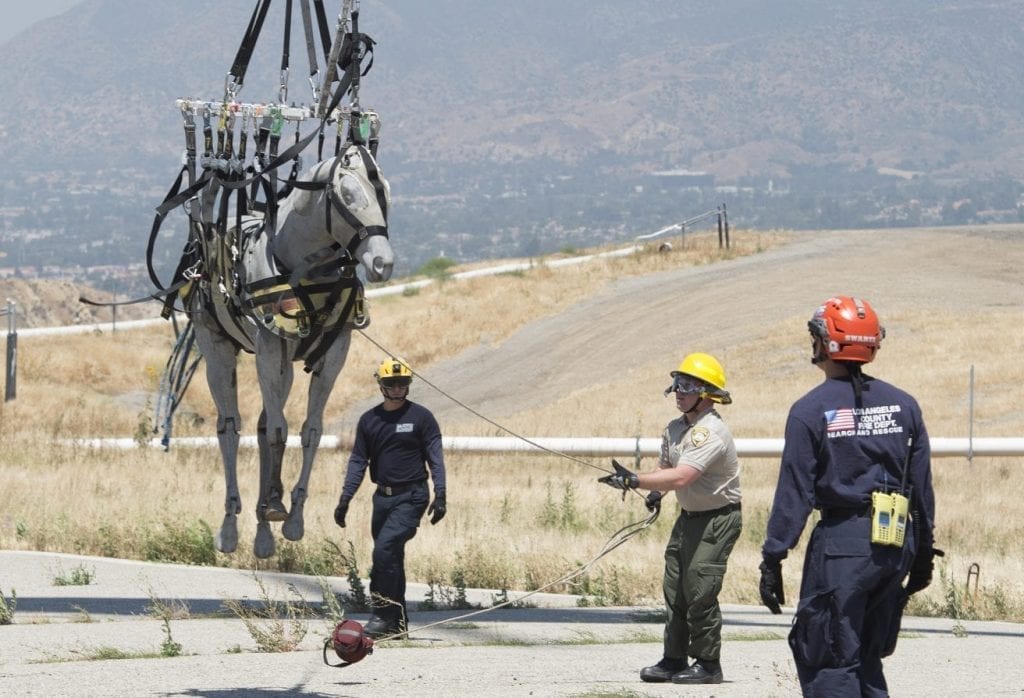
Emergency preparedness is important for all animals, but preparedness for horses and large animals is especially important because of their size and special transportation needs. Horses should be evacuated as soon as an EVACUATION WARNING is issued. Do not wait for the EVACUATION ORDER. If you are unprepared or wait until the last minute, you may need to leave your animals behind.
Create an Animal Evacuation Plan
- Before the emergency make arrangements to shelter your animals at two different locations far apart from each other.
- If you have large animals, evacuate when you hear the EVACUATION WARNING.
- Train horses to lead and trailer so that they become comfortable with the process.
- Keep your truck and trailer in safe, working condition (gas tank full). If you don’t have a truck and trailer, make arrangements in advance to have someone evacuate your animals.
- Know who is evacuating your animals. Be sure to exchange phone numbers, California Drivers License numbers and other relevant information with the person evacuating your horse. Know where your animals will be taken.
- Network with your neighbors prior to an emergency. Work together to help horse/pet owners on your street who do not have horse trailers or who are not home during an emergency.
Quick Tips for Large Animals
Mount fire extinguishers near barn entrances and around stables for easy access in the event of a barn fire. Store hay outside the barn in a dry covered area when possible. Also, the Los Angeles County Animal Care & Control Department has an Emergency Response Program that includes animal control officers and volunteers specially trained to deal with small and large animals during an emergency. To learn more, visit the Los Angeles County Animal Care and Control Emergency Response page.
Risks to Animals after the Disaster
Risks to animals after a fire include burned or cut paws, eating or inhaling toxic substances or residues, escaping because of downed fences or other damage, loss of shelter and shade, and a lack of water supply, power supply, and other services. Similar risks will be present after an earthquake or other disaster.
After the crisis has passed, it may be some time before you can return to your home, even if your house is intact and you are allowed to return, the area may not be safe for your pets. Anticipate visits from inspectors and workers and make arrangements to provide your pet with a secure place where they will be safe and out of harm’s way.
Keep in mind that when animals return to a changed landscape, they will be upset, disoriented, and easily stressed. Try to be calm and follow normal routines whenever possible. For more information, visit the Los Angeles County Animal Care & Control website.
Large Animal Shelter-in-Place
Shelter-in-place means providing optimum shelter on your property for your horses/livestock if you cannot evacuate. We do not endorse the Shelter-in-Place strategy for large animals.
If you MUST shelter in place:
- DO NOT TURN HORSES LOOSE – they may return home to a burning barn. Loose horses also cause serious problems for first responders.
- Maintain adequate clearance – the County Fire Department now recommends 200 ft. clearance around your property.
- Turn horses into arena with sufficient brush and tree clearance – Your horse corral should be made with metal pipes, not PVC or wood.
- Consider having the following items near the horse corral:
- Fire hose(s)
- Generator
- Multiple shovels placed strategically around property, axe, hoe, rake, broom, etc.
- Multiple ladders extended and placed at both ends of house and ready for use near the barn
- Portable AM/FM radio with spare batteries
- Hand-held FRS radios (walkie-talkies) and hand held scanner with spare batteries
- Masks, goggles, heavy working gloves and bandanas
- Use leather halters not nylon
Quick Tip for Horses in Barns
Post important addresses & telephone numbers by your telephones in the house and in the barn.

